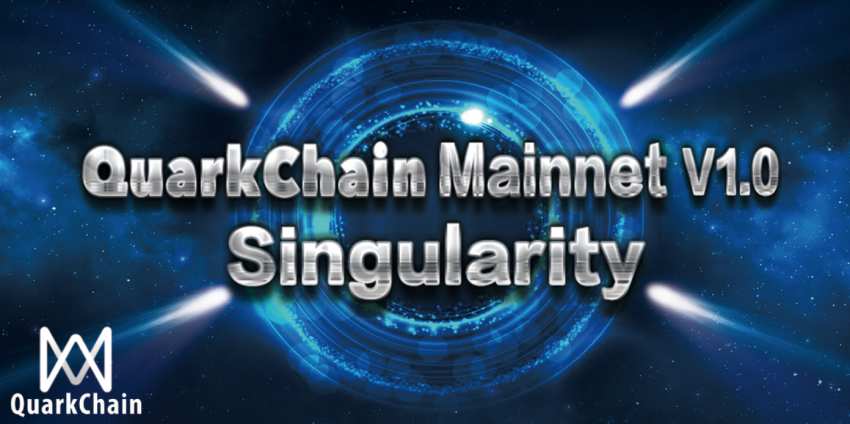Dear respected QuarkChain supporters, fans, and followers,
It was only a year since QuarkChain was founded. For a traditional industry, one year was very short. But for the industry of blockchain which has been through so many ups and downs, it seems being several years compared to other industries. During the past year, numerous “hot spots/projects” have emerged in the whole industry. However, the real pearls are mercilessly buried in the faked information, which makes people unable to grasp the key points. Many projects also got lost due to blindly following, and deviated from their original goals. QuarkChain is persistent in seeking the nature of blockchain in confusion, choosing to be a real shiner and achieving broader compatibility at the bottom layer. On April 30th, we are officially introducing QuarkChain’s mainnet V1.0 “Singularity”. From now on, in the vastness of the blockchain universe, Singularity will be the beginning of a new future.
A real platform system should be more efficient and compatible with more functions. With the addition of new features, the whole system will benefit and reach a consensus with a broader range of people. Moreover, it should have higher scalability so that when it is applied, it can continue expanding and accommodate newly developed techniques. At present, there is no such platform in the whole industry. QuarkChain develops a set of solutions based on insights and reflections which affect the evolution of the industry.
Now let’s formally introduce QuarkChain mainnet v1.0 Singularity’s design concept, technical configurations, ecosystem, and future plans.
QuarkChain Mainnet V1.0 “Singularity” Function Overview
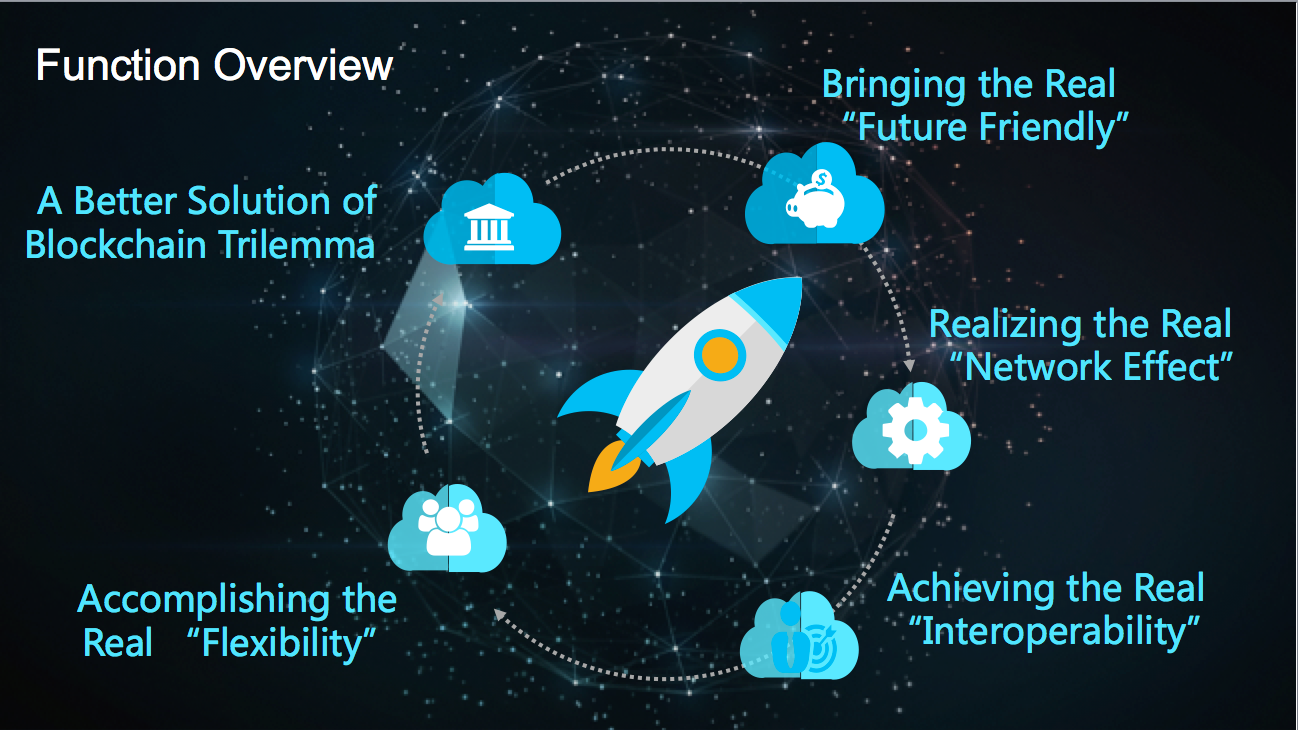
A Better Solution of Blockchain Trilemma
For public chain, there exists a blockchain trilemma problem: it is very difficult to design a blockchain system which can satisfy decentralization, security, and scalability at the same time. Especially, the scalability problem is one of the most difficult parts in the development of blockchain technology. Many projects provided their own solutions, and state sharding is the most efficient and difficult solution to achieve.
QuarkChain uses state sharding technology and a system structure of root chain-shards which can compatible with various consensus mechanisms. On the basis of high throughput, more than 51% hash power will be protected by root-chain, and compatible with decentralized PoW, PoS, and other consensus mechanisms. It puts forward an excellent solution to blockchain trilemma, which is an important contribution to the future development of the industry.
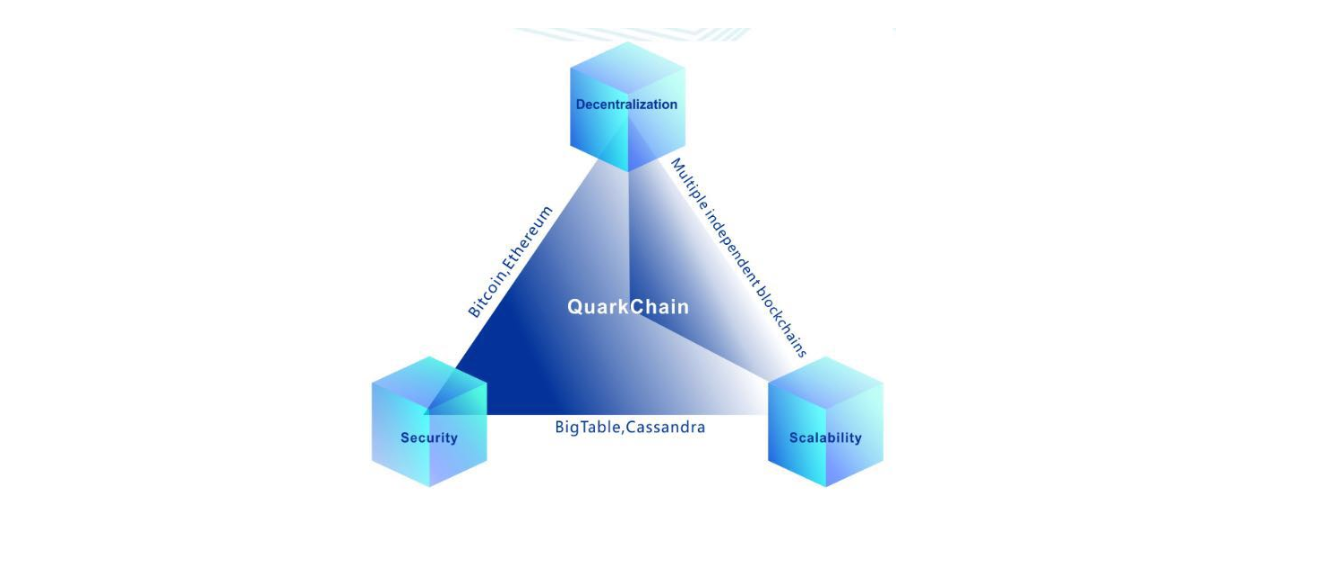
Accomplishing the Real “Flexibility”
The essence of blockchain technology comes from the arrangement and combination of the following four components:
- Consensus (POW, POS, DPOS, PBFT)
- Transaction model (BTC transaction model, different virtual machine, privacy transaction model)
- Ledger model (UTXO, Account model)
- Token economics
Boson consensus, exclusively developed by QuarkChain, enables every shard to have different consensus algorithms, ledger models, transaction models, and token economics. Relying on the high-performance cross-shard transactions, all assets on the shards can be interoperable. Thus, the blockchain world is provided with unified and efficient operation ways, and there are possibilities of massive adoption.
Because of the compatibility of multiple consensuses, miners do not need to make either-or choices. With the development of the blockchain industry, the mining community has been splitting up and consensuses also have been diluted. QuarkChain, through the flexible application of sharding technology, is able to accommodate the differences between different consensus mechanisms, ledger models, transaction models and token economics implemented on different shards, and to rely on QuarkChain network to achieve mutual circulation. Existing PoW miners can easily join the network and coexist with the PoS mechanisms, which can free the community from the split.
Achieving the Real “Interoperability”
The multi-native token mechanism is another innovation of QuarkChain. The tokens generated on QuarkChain are not like contract tokens such as ERC20 and TRC20, but have all the functions of a native token. The core is that the ledger model can directly support multiple native tokens.
Depending on QuarkChain’s flexible customization of four dimensions and multi-native token function, the existing blockchain can even split and become one of the shards on QuarkChain. By using multi-native tokens and cross-shard transactions, tokens can flow among different shards. The tokens circulating to different shards will have the function and form of shards, which brings the more extreme interoperability. Through compatibility and circulation, it is equivalent that the whole network has the functions of the new shards. In this way, by adding functional shards, new functions can be realized for the whole network, without considering the risk of forks caused by the functional upgrade.
For example, assuming that a shard of QuarkChain implements the function of privacy token (just modifying the transaction model), users can easily put QKC or other native tokens on the shard of privacy token, and then directly do privacy transactions. All processes are decentralized. When completing the transaction, move the token to other shards. This is equivalent to QuarkChain supporting this feature from the beginning.
Realizing the Real “Network Effect”
Users at the application level, such as industry/commerce, can also flexibly customize the shards to meet their needs by choosing the four elements mentioned above. For example, DEX needs to store order information in the ledger, while other DApp games need faster confirmation time and thus DPoS consensus will be favored. QuarkChain can also meet such needs by customizing shards. More industries, more users and more functions will enable the whole network to provide more and better services.
Bringing the Real “Future Friendly”
Blockchain technology is evolving rapidly. Taking the consensus mechanism as an example, the earliest PoW mechanism was prevalent, while the emerging DPoS mechanism attracted more attention in 2018. Now it turns to PoS mechanism. No one can predict what technology will become the mainstream in the future, and once a new mechanism or technology becomes the mainstream, to achieve it in the fastest and best way will get more support. Infrastructure should not only meet the current needs but also should face the future and meet the development needs for the next 5 to 10 years. QuarkChain relies on its flexible mechanism. When a new technology (whether a new consensus or a virtual machine) emerges, QuarkChain will always be able to adapt to these changes.
Technical indicators for V1.0
QuarkChain launched six versions of the testnet (testnet 2.0–2.6) and released 13 small versions after continuous improvements. A total of 1382 commits and 281 unit tests were conducted to ensure code security. Through strict code reviews, code audits by five authoritative security auditing companies (NCC, SlowMist, Chaitin, John Wick Security Lab, Knowsec) at home and abroad were conducted. Consensus security, P2P security, RPC security, encryption and signature security of open source code were all audited. A total of 29 security vulnerabilities were identified. All security vulnerabilities have now been repaired, and online submission was finally completed.
Github Link:
https://github.com/QuarkChain/pyquarkchain/releases
QuarkChain V1.0 “Singularity” configurations are as follows:
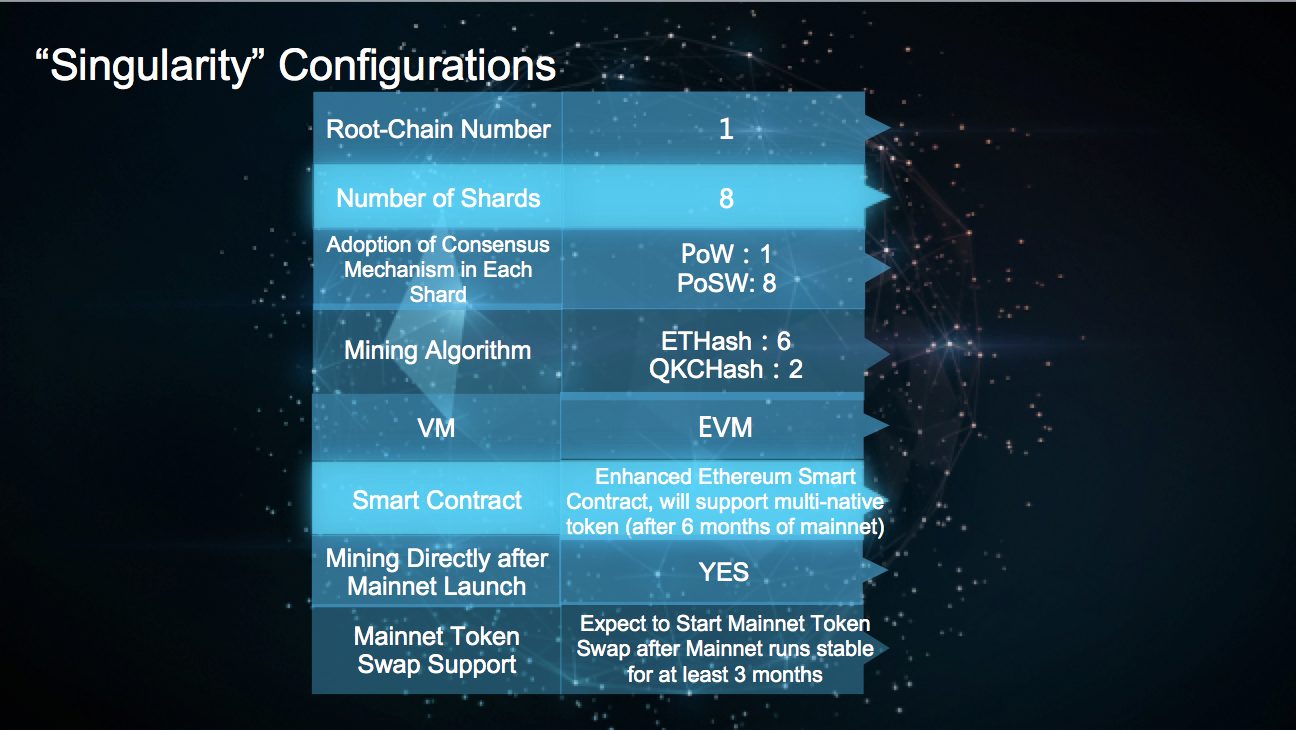
Mainnet Token Swap Support:
Support token swap in crypto wallet and exchange. We expect to start mainnet token swap after the mainnet runs stable for at least three months. Due to the working progress of the exchange and the hashpower of mainnet, the schedule may be changed.
QuarkChain Ecosystem
In addition to the improvement of QuarkChain’s own functions, relying on the efforts of expanding partners over the past year, there are now quite completed supporting facilities and partners to support QuarkChain mainnet.
Ecosystem Support
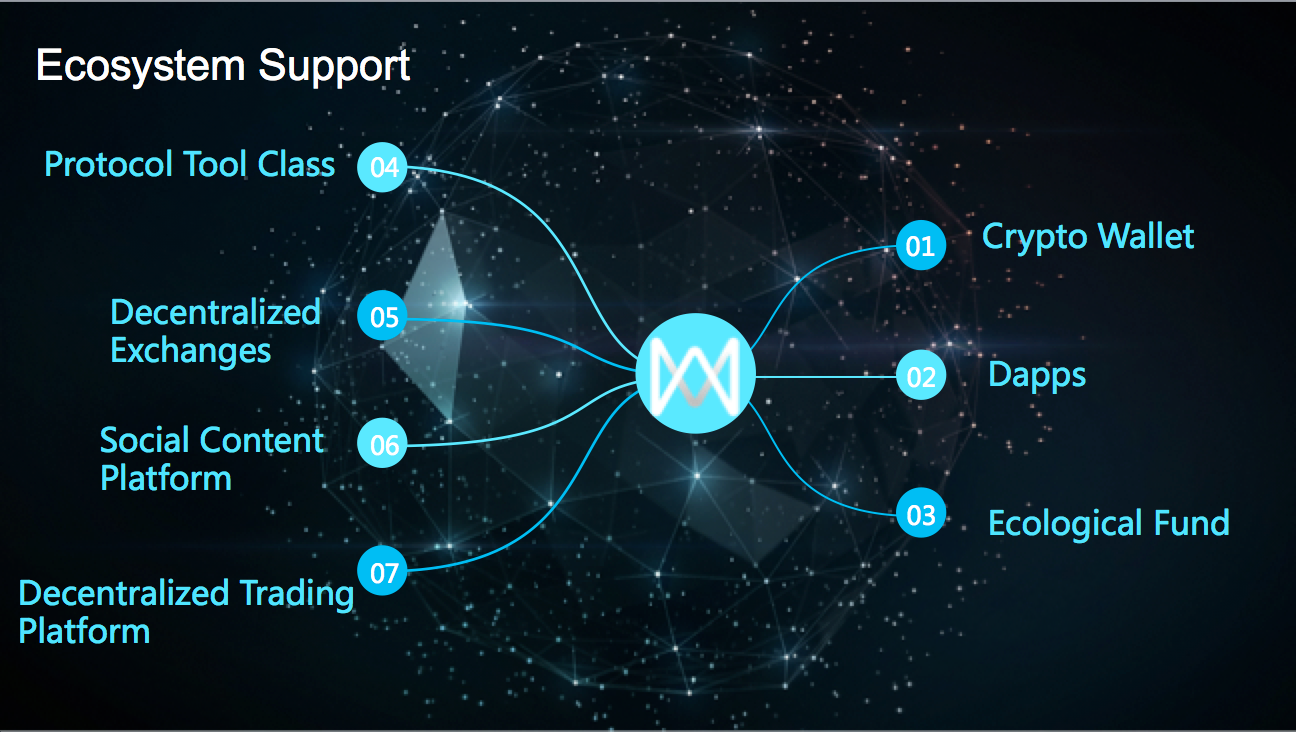
Crypto Wallet
qPocket is QuarkChain’s official wallet, which supports a variety of asset management. It now supports QKC, ETH, TRON, ERC20, and TRC20 tokens. qPocket will support more types of assets in the future, and it has cooperated and accessed with a large number of DApps including game DApps. qPocket is committed to becoming a new generation of DApp traffic entrance.
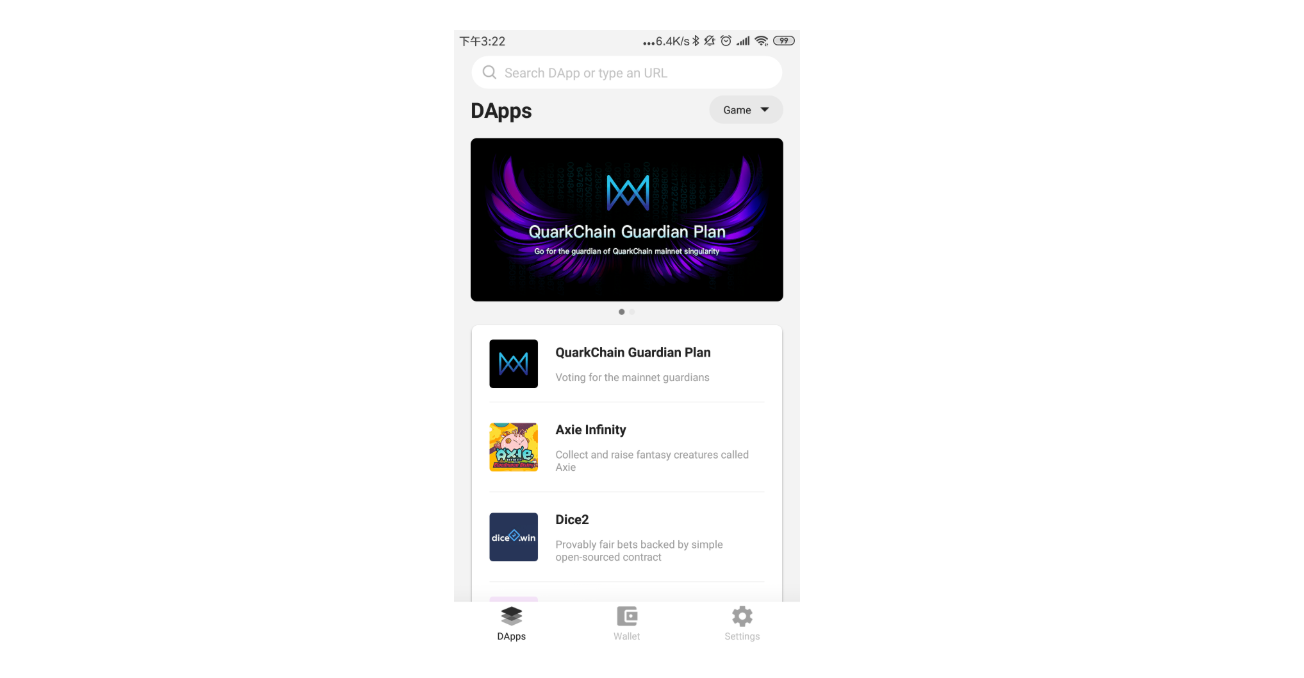
In addition, QuarkChain has worked closely with top wallet products in the industry. While Cobo wallet and Math wallet is involved in the Guardian Plan, they will also support the management of (mainnet coin) QKC in the future.
DApp
At present, a large number of applications are working closely with QuarkChain, and the development based on QuarkChain is about to start. The types of applications are complete. QuarkChain’s DApp ecosystem has begun to take shape, with productive ecosystems, evolving towards integrity and maturity.
In the field of games, QuarkChain has signed a willingness to cooperate with a large number of game applications. A large number of users have begun to develop games based on QuarkChain, including chess and cards, virtual asset collection and so on.
Ecosystem Fund
QuarkChain established a 50 million USD open-ended fund named QEF (QuarkChain Eco-Fund), and it is used for investing and supporting potential blockchain projects in primary or secondary markets.
Protocol Tool Class
The application layer of the public chain needs the support of complete Layer 2 protocols and tools, which are complete in the QuarkChain ecosystem. Cross-chain protocols, oracle machine, encryption protocols, and arbitration protocols all have corresponding products.
Decentralized Exchanges
The complete public chain cannot be separated from the support of exchanges. QuarkChain’s ecosystem includes more than three worked-well decentralized exchanges.
Social Content Platform
Protecting the copyright of content creators and realizing their value is one of the foreseeable core values of the blockchain. A large number of related applications have been confirmed to migrate to the QuarkChain mainnet, including social media, Live gift delivery platform, blog platform and so on.
Decentralized Trading Platform
The use of token circulation for payment is one of the ways that blockchain technology empowers the economy. QuarkChain’s ecosystem includes applications such as food purchase, hotel reservation, and so on.
Enterprise Solutions
QuarkChain mainnet will propose characteristic solutions for different needs of enterprises. It has already landed in the following areas. In the future, more functions and customized shards will be connected to the mainnet. (Due to confidentiality agreements, only service areas will be introduced, and specific cooperation information will be released at the appropriate time in the future.)
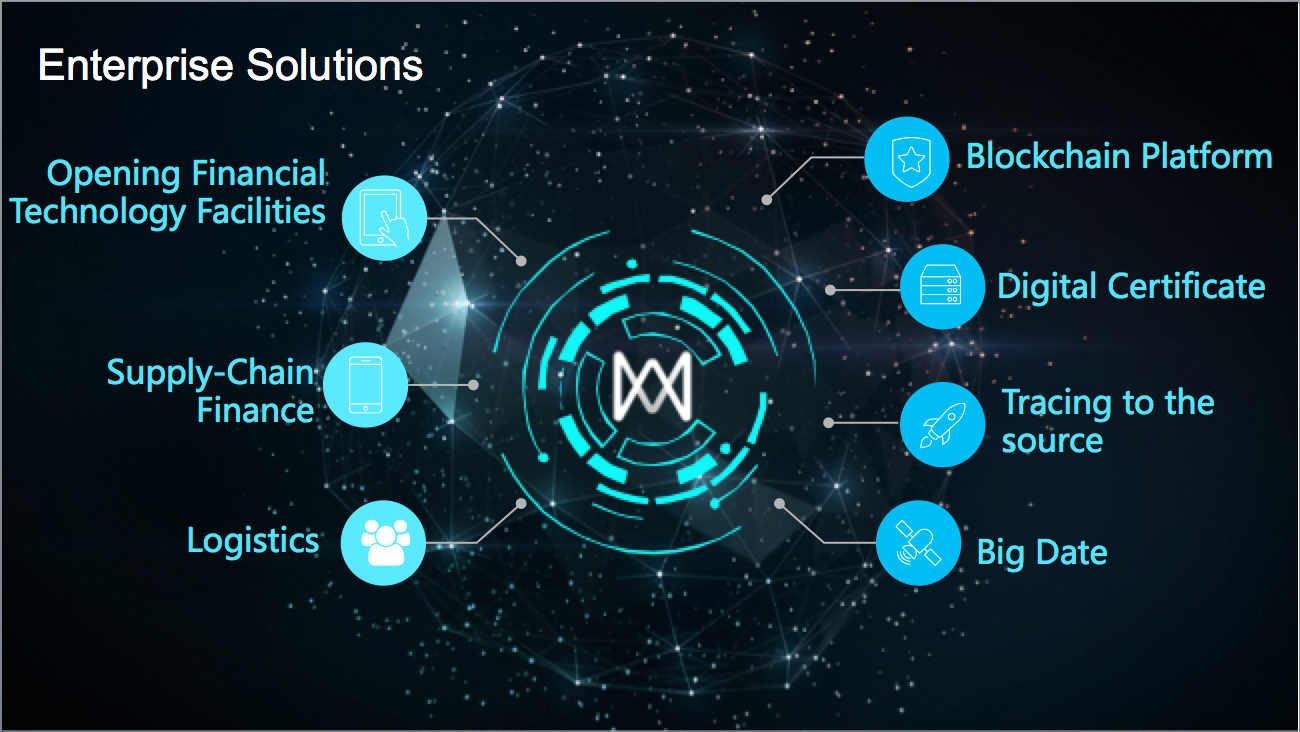
BlockChain Platform
QuarkChain has signed a cooperation agreement to establish a national-level blockchain platform infrastructure for a temporarily confidential customer. This infrastructure will significantly enhance the efficiency of the business for application which has massive customers, and QuarkChain will be responsible for the long-term maintenance and iteration of this platform.
Opening Financial Technology Facilities
The difference between open financial technology facilities and decentralized financial technology facilities is that the former will be well compatible with the current technological evolution path of Fintech. QuarkChain-based financial technology facilities will be stable in value capture and storage. Financial derivatives, lending, high-frequency payment, micro-payment, encrypted trusteeship, decentralized transactions, KYC, identity, insurance, investment, forecasting market, quantitative trading, securities, bonds, factoring, and other aspects are forming a wide range of cooperation and application landing cases.
Supply-chain Finance
Blockchain is a fusion technology in many fields, such as point-to-point communication, digital encryption, distributed ledger, multi-party collaborative consensus algorithm, etc. It has the characteristics of non-tampering and data traceability and it is very suitable for the supply chain‘s financial business scenarios that multi-party can participate in. QuarkChain has signed cooperation agreements with famous chemical e-commerce platforms and e-commerce logistics factoring companies.
Logistics
The global logistics industry will continue to develop rapidly in the next five years, but its cumbersome process, price manipulation, complex and inefficient goods tracking and high risks of material loss and theft hinder its further development. To solve these problems, QuarkChain uses blockchain technology to provide solutions for the logistics industry: verifying business authenticity among multiple nodes in the chain; splitting transportation cost into terminals, transparent cost, promoting exceptional management and reducing logistics costs; obtaining first-hand data through the Internet technology to improve the authenticity of data on the chain; multi-node co-maintenance to improve business flow rate.
Tracing to the Source
Blockchain technology is applied to store data in the traceability system. Because of its inherent characteristics, it is difficult to delete and change the stored data. It provides a new trust mechanism that differs from the centralized data storage in the original traceability system, thus greatly improving the credibility of the traceability system. QuarkChain has signed partnerships with a high-end tea company and a well-known beef importer company.
Digital Certificate
Data/electronic credentials face problems such as possible falsification and difficulty in self-identification. A consensus storage system for data/electronic credentials is established through blockchain. Based on multi-level encryption and multi-dimensional privilege control technology, data/electronic credentials can be safely saved. A new ecosystem of distributed storage of digital credentials with high digitalization and strong reliability will achieve. QuarkChain has reached a preliminary cooperation intention with a well-known laboratory.
Big Data
In the era of big data, the huge amount of data that has been reserved is like a gold mine waiting to be excavated. But the existing tools fell behind to deal with massive data. It mainly embodies in three aspects: data reliability, data transaction, and data functionalization. Blockchain has natural advantages in data validation, credit enhancement, and data transaction through smart contracts, but there is no blockchain which can carry a large amount of data at present. (ETH, which is recognized as blockchain 2.0, currently only stores 2.2TB of data) QuarkChain relies on years of experience in the field of scalability to build a blockchain infrastructure for mass data storage (up to 5PB, and can continue to expand as needed) to solve the problem of data uplinking. A blockchain with the ability to store massive data will provide credit support, trusted storage and authenticating services for the data industry all over the world. It will become an authoritative global library in the field of data specialty. Once taking this spot, it will have the first-mover advantage of the big data industry.
Roadmap after Singularity
The mainnet launching is only the first step. After the completion of the mainnet launching, QuarkChain team will turn to the “first driving force” stage to further improve the mainnet functions, add more shards functions, and construct DApp ecosystem.
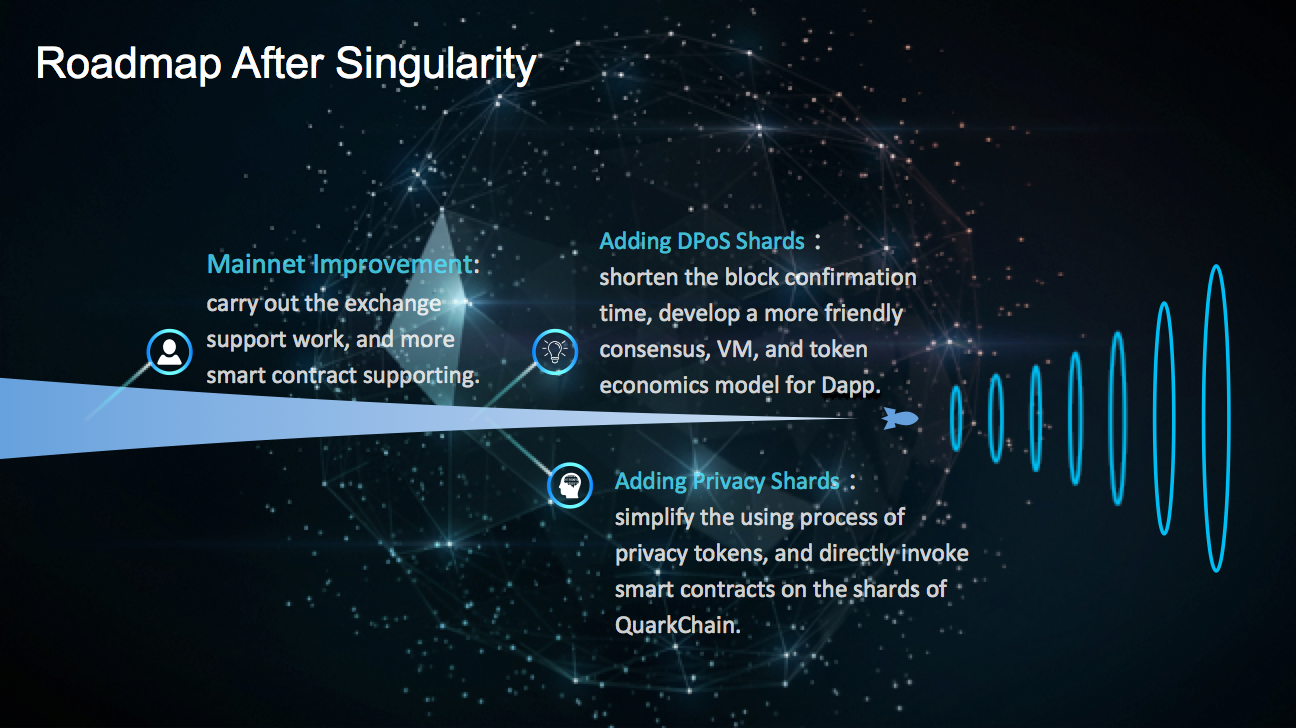
Mainnet improvement
After the mainnet launch, the team will first carry out the exchange support docking work, and begin to enhance the supports for more smart contracts.
Adding Shards
According to the design, in the future, each shard in QuarkChain can be compatible with various smart contracts and consensus mechanisms, whether EVM, NeoVM, WASM, PoW, PoS, DPoS, etc, can be found in the existing ones. With this design, any DApp can be transferred to QuarkChain 100% smoothly. At the same time, on the shard, each DApp can create its own native token, which directly supports payment and Gas on the chain.
Adding DPoS Shards
QuarkChain will add DPoS shards after the mainnet launch, which greatly shortens the block confirmation time, reduces the delays of all interactions and confirmations, and enables users to have a better quality of experience (QoE).
In addition, in order to enable QuarkChain to provide better support for DApp and transform the powerful DApp ecosystem, a more friendly consensus, virtual machine and token economics model for DApp will be developed.
Adding Privacy Shard
The use of private token protects users’ privacy and security. In most cases, the process of using a private token is to open an account, buy token, send the transaction to the privacy chain, complete the transaction with the private token, and then return the token that completed transaction back to the original chain. This process is more complicated. QuarkChain will give priority to add privacy shards, simplify the using process of privacy tokens, and directly invoke smart contracts on the shards of QuarkChain.
Although compared with the destined brilliance of the future, the present praise is still excessive, and the current achievements are still insignificant. However, we still want to commemorate the progress we had made many times in the past year, breaking waves in the storm of the industry. “Singularity” has come down, and with the support of communities, partners and developers, it gradually pressurized and warmed up, the big bang of the future blockchain universe will come at any time.
Appendix:
- QuarkChain’s Boson Consensus:https://medium.com/quarkchain-official/quarkchain-explained-part-4-sharding-in-quarkchain-consensus-8032704319bd
- Supporting Multi-Native-Tokens in a Single Blockchain: https://medium.com/quarkchain-official/supporting-multi-native-tokens-in-a-single-blockchain-686fc65f5931
- Proof of Staked Work — A Simple PoW/PoS Hybrid Consensus:https://medium.com/quarkchain-official/proof-of-staked-work-ef36f9499279
- Order-Statistics-Based Hash Algorithm:https://medium.com/quarkchain-official/order-statistics-based-hash-algorithm-e40f108563c4
